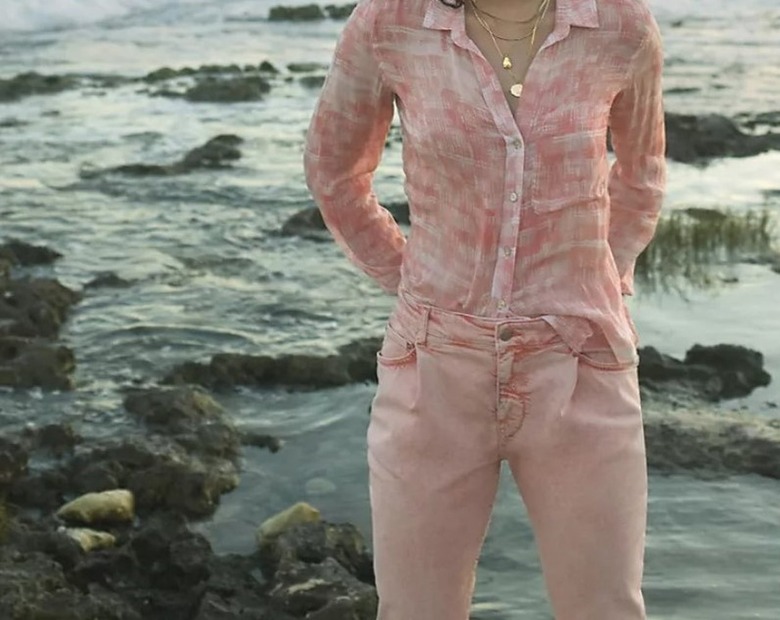How To Mineral Wash Clothes
We may receive a commission on purchases made from links.
Considering the acid-wash trend of the 1980s is back with a vengeance, stores are charging a lot of money for T-shirts, denim, and other garments that are designed to look weathered and worn. You can save money and be on-trend if you know how to stonewash jeans by hand and create vintage-wash T-shirts using your own old tees. There are a few ways to achieve the mineral wash look at home depending on what effect you have in mind.
Here's what to know about mineral washing clothes.
Stone Wash vs. Acid Wash vs. Mineral Wash
Stone Wash vs. Acid Wash vs. Mineral Wash
The terms "stone wash," "acid wash," and "mineral wash" are sometimes used interchangeably to describe the weathered, lightened treatment that was so popular in '80s and '90s fashion. The processes are technically different, though. Stone washing is done by literally washing fabric with stones in an industrial washer. The stones beat against the fabric over and over as the washer's tumbler rotates until the fabric is lightened all over. Acid washing or mineral washing is done by applying chemical agents to fabric to create the weathered look.
Before Getting Started With Mineral Washing
Before Getting Started With Mineral Washing
Take a few precautions before starting on your DIY project. If you're working with bleach, plan to work outdoors or in a well-ventilated space. Wear nitrile gloves and eye protection if you're going to be handling bleach. Also check the fabric tag on anything you're planning to transform. Like tie-dyeing methods, mineral wash methods work best on cotton and other natural fibers.
Don't mineral wash hoodies or T-shirts you cherish without doing a practice run first. Use an old T-shirt or stained hand towel to test a few methods before getting to work on the clothing you really want to dye. Use cardboard or newspaper inside a T-shirt or jeans as a barrier between layers to keep bleach or paint from soaking through from the front to the back.
Mineral Washing With Bleach
Mineral Washing With Bleach
So how do you mineral wash a shirt? Basic chlorine bleach is typically used for this project. Bleach lightens fabric color, so using it very sparingly and evenly across the entire garment creates the effect of fabric that's been worn, washed, and folded hundreds of times. Bleach can also be used to create a bolder tie-dye effect on tees and other garments.
There are a couple of ways to approach this project. One uses pumice stones that have soaked in bleach for a few minutes:
- Lay the garment flat on a base of newspaper or cardboard.
- Wearing protective gloves, scrub the fabric with the pumice stone, dipping the stone back into a container of bleach when it dries out.
- Let the clothing sit for about 10 minutes to give the bleach some time to work and then do another round of scrubbing if you want a more weathered effect.
Alternatively:
- Pour a small amount of bleach into a clean spray bottle and add an equal amount of water. (Adjust the ratio to include more water if you prefer a subtle bleach effect.)
- Spritz the flat garments with the bottle's nozzle on the mist setting.
- Create more of a trendy tie-dye pattern with bleach by rolling or gathering the material and holding it in place with rubber bands before spritzing the bleach solution.
Whichever method you choose, let bleached clothing sit for 15 to 30 minutes after you're finished. Rinse well under cold water and then launder pieces in the washer with cool water and detergent. Wash these garments alone so other pieces of clothing aren't damaged by any remaining bleach.
Getting the Mineral-Wash Effect Without Bleach
Getting the Mineral-Wash Effect Without Bleach
Handling chlorine bleach has some disadvantages that you might prefer to avoid, especially if you're not able to work outdoors or want to make this a more kid-safe activity. Try using fabric paint if you want to DIY mineral wash tees and other clothes without bleach. This method may create a more realistic all-over mineral-wash effect than bleach; however, the effect may fade over time as you wash the clothing. Follow these steps:
- Grab some pebbles of varying sizes from your neighborhood and wash them with soapy water.
- Mix white fabric paint with enough water to give it the consistency of thin soup and submerge the pebbles in the paint.
- Pull the pebbles out and let excess paint drip off.
- Then place the pebbles on top of the garment and roll them around under your palm.
- Repeat this process until one entire side of the garment is covered.
- Let it dry before flipping it and stone-painting the other side.
When you have to wash the garment, turn it inside out and use mild detergent and gentle washer settings to protect your paint job.
